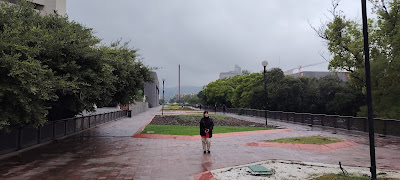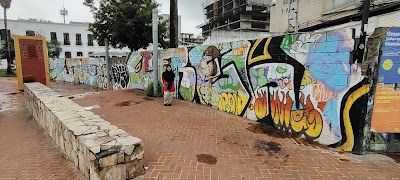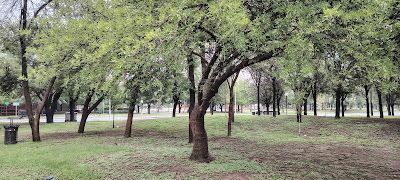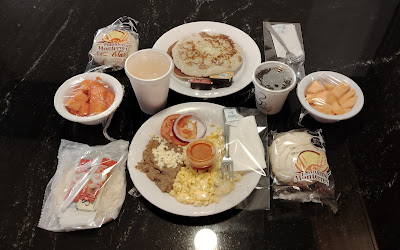"I know that if I wasn't scared, something's wrong, because the thrill is what's scary..." - Richard Pryor
 |
| (Paseo Santa Lucia, Monterrey, a man-made canal) |
Activity: Monterrey City Tour
Flight: VB642 MTY 1530/HAV 2015 (Viva Air) Route: Monterrey, Mexico - Havana, Cuba
Hotel: Home In La Havana, Cuba
Very early in the morning we called the reception to order our room-service breakfast. We ordered a set of pancakes and maple syrup and a set of eggs and beans with orange juice and coffee. All were delivered through the Breakfast Service Box. We had half a morning to spend in Monterrey city before our VB642 1530 hrs flight to Havana, Cuba. Heavy rain was predicted so we were prepared with jackets and umbrellas.
.jpg) |
| (Ready to explore Monterrey in the rain) |
We booked an Uber to send us to the Macroplaza to visit some of the attractions around the area. The Palace Museum is part of the Three Museums complex, along with the Museum of Mexican History and the Museum of the Northeast. It is also part of the Paseo Santa Lucía complex. The palace was constructed between 1895 and 1908. It is built from pink quarry stone in a neoclassical style, featuring Corinthian columns, a statue of Victory on its facade.
 |
| (A large fountain at the Macroplaza) |
 |
| (Statue of Fray Servando Teresa De Mier) |
 |
| (Walking in the rain at the Macroplaza or Gran Plaza) |
 |
| (The Maternidad Yacente, the Reclining Motherhood statue) |
Fuente de Neptuno or Fountain of Neptune is a majestic bronze fountain depicting Neptune with his trident - a symbol of abundance and the city's hydraulic development. It adds a dramatic water element to the plaza.
 |
| (Fuente de Neptuno, a symbol of Monterrey’s resilience and growth) |
 |
| (Fountain of Life with a view of Sierra Madre Mountain) |
 |
| (A beautiful modern Italian-style theater) |
 |
| (Biblioteca Central del Estado - A library) |
 |
| (La Grand Plaza in the heart of Monterrey) |
 |
| (A large modern Sundial, an interesting sculpture) |
 |
| (A long wet walk to the Fero Del Commercio) |
 |
| (Steel sculptures decorating the Macroplaza) |
Faro del Comercio Monterrey, Mexico Macroplaza, or the Lighthouse of Commerce is an emblematic monument of the city of Monterrey, located in the Macroplaza in front of the Monterrey Cathedral and behind the Municipal Offices. El Faro del Comercio was built in commemoration of the founding of the Chamber of Commerce of Monterrey's on its 100-year anniversary.
 |
| (Faro Del Comercio monument) |
 |
| (The Monterrey Cathedral) |
The monument to Workers of Nuevo León is a tribute to all men and women workers who give life to this industrial city. It was designed by the sculptor Cuauhtémoc Zamudio. Every May 1st (International Workers’ Day), government authorities and unions gather here for wreath-laying, speeches, and a moment of silence in memory of labor martyrs from Chicago, Cananea, and Río Blanco.
 |
| (Monument to the Workers) |
Ignacio Zaragoza Seguín was born in Bahia del Espiritu Santo, then a Mexican territory in the state of Coahuila and Texas, USA. The second of eight sons of Veracruz soldier Miguel Zaragoza Valdés and Texan María de Jesús Seguin Martínez, he was a distinguished Mexican military man, Minister of War for President Benito Juárez in 1861, who defeated the French in the city of Puebla on May 5, 1862.
 |
| (Monterrey City Hall - the Palacio Municipal de Monterrey) |
 |
| (Statue of Ignacio Zaragoza Seguin) |
We took pictures at Monterrey signage at the Macroplaza. The Macroplaza is a testament to Monterrey's twentieth century ambition. This city block wide series of interconnected squares, also known as the Gran Plaza, was created in the 1980s by the demolition of a prime chunk of city-center real estate. A controversial but ultimately successful piece of redevelopment. Its charm has increased over the years as the once bare urban space has been transformed into the largest public square in the world. It has been softened by parks, trees and fountains.
 |
| (Monterrey Signage at the Macroplaza) |
 |
| (Signage of Nuevo Leon) |
 |
| (Arrived at the airport on time) |
 |
| (Dropping off our check-in luggage) |
We already check-in online and were just in time to check-in our luggage. For entry into Cuba, we were requested to apply for Digital Travellers Entry Form online. As wi-fi in the airport was intermittent and internet roaming was also limited, it took us some time to fill in the forms but we managed to get the QR codes in time for boarding.
 |
| (Struggling to complete the Arrival Forms on-line) |
 |
| (Yeay! We are off to Cuba...) |
 |
| (Happy faces at the Boarding Lounge) |
Our VB642 flight to Cuba was delayed for almost an hour. Around 9.30 pm, we landed safely at José Marti International Airport in Havana, Cuba. The airport is located in the municipality of Boyeros, twenty kilometres southwest of the centre of Havana, Cuba. It is Cuba's main international airport, and serves several million passengers each year.
 |
| (Our flight was delayed for more than an hour) |
 |
| (Having Chinese food for lunch) |
 |
| ( A long queue and tiring wait) |
 |
| (Viva plane ready to board passengers) |
 |
| ( A short walk to the plane) |
 |
| (The sun is setting at the horizon) |
After immigration checks and custom clearances which were surprisingly very fast and efficient, we were met by a taxi driver who sent us to our rented apartment located in the Old Quarters in Villegas Havana. Even though it was nearly midnight when we reached the area, the badly lighted neighbourhood was still full of youngsters playing loud musics, dancing and talking loudly. Lisa, the landlady was already waiting for us. Steep narrow staircases led us to the two rooms apartment on the 3rd floor. Lisa's friend helped us to carry our big bags upstairs for a small tip. This apartment will be our lodging for the next three nights.
Our first impression of Havana Vieja neighbourhood at night was a bit scary!
 |
| (An old cathedral in front of our home in Havana Vieja) |
 |
| (Beautiful view from the 3rd floor of our apartment) |


.jpg)

.jpg)














































.jpg)
.jpg)











No comments:
Post a Comment